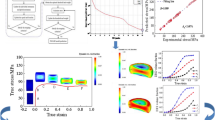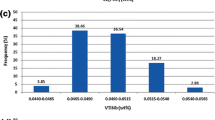Abstract
Economic and safe management of nuclear plant components relies on accurate prediction of welding-induced residual stresses. In this study, the distribution of residual stress through the thickness of austenitic stainless steel welds has been measured using neutron diffraction and the contour method. The measured data are used to validate residual stress profiles predicted by an artificial neural network approach (ANN) as a function of welding heat input and geometry. Maximum tensile stresses with magnitude close to the yield strength of the material were observed near the weld cap in both axial and hoop direction of the welds. Significant scatter of more than 200 MPa was found within the residual stress measurements at the weld center line and are associated with the geometry and welding conditions of individual weld passes. The ANN prediction is developed in an attempt to effectively quantify this phenomenon of ‘innate scatter’ and to learn the non-linear patterns in the weld residual stress profiles. Furthermore, the efficacy of the ANN method for defining through-thickness residual stress profiles in welds for application in structural integrity assessments is evaluated.







Similar content being viewed by others
References
P.J. Withers: Reports Prog. Phys., 2007, vol. 70, pp. 2211–64.
R6 Revision 4: Assessment of the integrity of structures containing defects, Gloucester, 2009.
G.S. Schajer: Practical Residual Stress Measurement Methods, Wiley, Chichester, 2013, pp. 6-24.
M.T. Hutchings, P.J. Withers, T.M. Holden and T. Lorentzen: Introduction to the characterization of residual stress by neutron diffraction, Taylor and Francis, London, 2005, pp. 149-99.
M.B. Prime: J. Eng. Mater. Technol., 2001, vol. 123, pp. 162-68.
M.C. Smith, P.J. Bouchard, M. Turski, L. Edwards and R.J. Dennis: Comput. Mater. Sci., 2012, vol. 54, pp. 312–28.
W. Woo, G.B. An, E.J. Kingston, A. T. DeWald, D.J. Smith and M.R. Hill: Acta Materialia, 2013, vol. 61, pp. 3564–74.
P.J. Withers, M. Preuss, A. Steuwer and J.W.L. Pang: J. Appl. Crystallogr., 2007, vol. 40, pp. 891–904.
F. Hosseinzadeh, J. Kowal, and P.J. Bouchard: J. Eng., 2014, pp. 1–16, DOI:10.1049/joe.2014.0134.
B. Ahmad and M.E. Fitzpatrick: Metall. Mater. Trans. A, 2016, vol. 47, pp. 301–13.
P.J. Bouchard: Int. J. Press. Vessel. Pip., 2008, vol. 85, pp. 152–65.
Christopher M. Bishop: Neural networks for Statistical Pattern Recognition, Oxford University Press, Oxford, 1994, pp. 1-27.
H.K.D.H. Bhadeshia, R.C. Dimitriu, S. Forsik, J.H. Pak and J. H. Ryu: Mat. Sci. Technol., 2009, vol 25, pp. 504-10
İ. Toktaş and A.T. Özdemir: Expert Syst. Appl., 2011, vol. 38, pp. 553–63.
M.G. Na, J.W. Kim, D.H. Lim and Y.-J. Kang: Nucl. Eng. Des., 2008, vol. 238, pp. 1503–10.
S. Song, P. Dong and X. Pei: Int. J. Press. Vessel. Pip., 2015, vol. 126–127, pp. 58–70.
A. H. Mahmoudi, S. Hossain, M. J. Pavier, C.E. Truman and D.J. Smith: Exp. Mech., 2009, vol. 49, pp. 595-604.
R.D. Haigh, M.T. Hutchings, J.A. James, S. Ganguly, R. Mizuno, K. Ogawa, S. Okido, A.M. Paradowska and M. E. Fitzpatrick: Int. J. Press. Vessel. Pip., 2013, vol. 101, pp. 1-11.
T. Pirling, G. Bruno and P.J. Withers: Mater. Sci. Eng. A, 2006, vol. 437, pp. 139-44.
F. Hosseinzadeh and P.J. Bouchard: Exp. Mech., 2012, vol. 53, pp. 171–81.
M.B. Prime, R.J. Sebring, J.M. Edwards, D.J. Hughes and P.J. Webster: Exp. Mech., 2004, vol. 836, pp. 1–10.
P. Pagliaro, M. B. Prime, H. Swenson and B. Zuccarello: Exp. Mech., 2009, vol. 50, pp. 187–94.
D.E. Rumelhart, G.E. Hinton and R.J. Williams: Nature, 1986, vol. 323, pp. 533–36
-K. Hornik, M. Stinchcombe and H. White: Neural Networks, 1989, vol. 2, pp. 359-66.
MATLAB: MATLAB and Neural Network Toolbox Release 2012a, The MathWorks Inc., Natick, MA, 2012.
M.F. Møller: Neural Networks, 1993, vol. 6, pp. 525–33.
P.J. Bouchard: Int. J. Press. Vessel. Pip., vol. 84, 2007, pp. 195–222.
D.J.C. Mackay: PhD thesis, California Institute of Technology, 1991.
R.J. Mammone: Artificial Neural Networks for Speech and Vision, Chapman & Hall Inc., New york, 1993, pp. 126-42.
S. Hossain: PhD thesis, University of Bristol, 2005.
Acknowledgments
The authors are grateful for funding received from EDF Energy, AMEC Power and Process Europe, and the Lloyd’s Register Foundation. The award of neutron beamtime by the Institut Laue-Langevin (ILL) is also gratefully acknowledged. Michael Fitzpatrick and Jino Mathew are funded by the Lloyd’s Register Foundation (LRF), a charitable foundation helping to protect life and property by supporting engineering-related education, public engagement, and the application of research. Pete Ledgard and Stan Hiller from the Open University, and Paul English from the University of Manchester are also acknowledged for their assistance for carrying out the experiments.
Author information
Authors and Affiliations
Corresponding author
Additional information
Manuscript submitted January 25, 2017.
Rights and permissions
About this article
Cite this article
Mathew, J., Moat, R.J., Paddea, S. et al. Through-Thickness Residual Stress Profiles in Austenitic Stainless Steel Welds: A Combined Experimental and Prediction Study. Metall Mater Trans A 48, 6178–6191 (2017). https://doi.org/10.1007/s11661-017-4359-4
Received:
Published:
Issue Date:
DOI: https://doi.org/10.1007/s11661-017-4359-4




